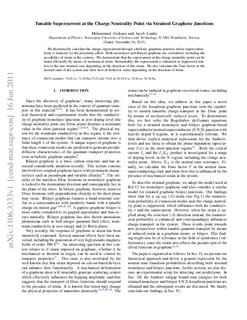| dc.contributor.author | Alidoust, Mohammad | |
| dc.contributor.author | Linder, Jacob | |
| dc.date.accessioned | 2017-10-26T14:06:03Z | |
| dc.date.available | 2017-10-26T14:06:03Z | |
| dc.date.created | 2011-10-24T15:39:00Z | |
| dc.date.issued | 2011 | |
| dc.identifier.citation | Physical Review B. Condensed Matter and Materials Physics. 2011, 84 (3), . | nb_NO |
| dc.identifier.issn | 1098-0121 | |
| dc.identifier.uri | http://hdl.handle.net/11250/2462448 | |
| dc.description.abstract | We theoretically calculate the charge-supercurrent through a ballistic graphene junction where superconductivity is induced via the proximity-effect. Both monolayer and bilayer graphene are considered, including the possibility of strain in the systems. We demonstrate that the supercurrent at the charge neutrality point can be tuned efficiently by means of mechanical strain. Remarkably, the supercurrent is enhanced or suppressed relative to the nonstrained case, depending on the direction of this strain. We also calculate the Fano factor in the normal state of the system and show how its behavior varies depending on the direction of strain. | nb_NO |
| dc.language.iso | eng | nb_NO |
| dc.publisher | American Physical Society | nb_NO |
| dc.title | Tunable supercurrent at the charge neutrality point via strained graphene junctions | nb_NO |
| dc.type | Journal article | nb_NO |
| dc.type | Peer reviewed | nb_NO |
| dc.description.version | acceptedVersion | nb_NO |
| dc.source.pagenumber | 6 | nb_NO |
| dc.source.volume | 84 | nb_NO |
| dc.source.journal | Physical Review B. Condensed Matter and Materials Physics | nb_NO |
| dc.source.issue | 3 | nb_NO |
| dc.identifier.doi | 10.1103/PhysRevB.84.035407 | |
| dc.identifier.cristin | 847572 | |
| dc.description.localcode | This is the authors' accepted and refereed manuscript to the article. | nb_NO |
| cristin.unitcode | 194,66,20,0 | |
| cristin.unitname | Institutt for fysikk | |
| cristin.ispublished | true | |
| cristin.fulltext | postprint | |
| cristin.qualitycode | 2 | |
